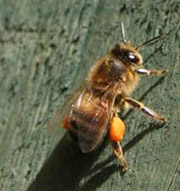Research
- Assessing mating conditions in the West Wales valleys: How much effect does the weather have on the mating success of queens and is there genetic variation in the ability of queens to mate successfully in less than ideal weather? Or is it the drones (that are being negatively affected by viral and other diseases, or pesticide residues) that are the cause of poor mating? Does the time of year that queens mate affect the likelihood of them acquiring sexually transmitted viruses such as Deformed Wing Virus? This is important as queen failure seems to be an increasingly frequent cause of colony loss.
- Refining methodology to be used in monitoring and assessing colonies (eg most efficient and accurate method for monitoring varroa load). This is important as we aim to screen quite a large number of colonies in yr 2 to locate those with the best characteristics to take forward to the breeding stage, and we need to devise protocols that are time-efficient yet accurate.
What is the role of genetics in the program?
Note that this prohect does NOT involve genetic modification: we are only proposing to use genetic variation that is already present in the local honeybee population.
 We can use simple genetic techniques to investigate the background of bees going into the program (eg, do they contain a large proportion of “native” genes or do they have substantial proportion of genes from foreign sources). One danger of breeding bees is loss of genetic diversity, and we aim to use modern genetictechniques that are in regular use in the well-equipped laboratories at Bangor to evaluate this and use the information to guide the selection of colonies for the breeding program. For example, we can look at the particular form of the gene at the “sex determination locus” to ensure maximum diversity in the breeding colonies to reduce future problems with “spotty brood” (females need two different versions of this gene on each copy of their genetic material in order to develop normally).
We can use simple genetic techniques to investigate the background of bees going into the program (eg, do they contain a large proportion of “native” genes or do they have substantial proportion of genes from foreign sources). One danger of breeding bees is loss of genetic diversity, and we aim to use modern genetictechniques that are in regular use in the well-equipped laboratories at Bangor to evaluate this and use the information to guide the selection of colonies for the breeding program. For example, we can look at the particular form of the gene at the “sex determination locus” to ensure maximum diversity in the breeding colonies to reduce future problems with “spotty brood” (females need two different versions of this gene on each copy of their genetic material in order to develop normally).
 Genetic diversity is also important within honeybee colonies; queens may mate with up to 20 males (drones) so that the resulting colony is composed of different subfamilies, each with a different father. Research has shown that hives with high levels of genetic diversity are more vigorous, long-lived and disease resistant than hives with low diversity. If genetic markers (characteristic polymorphisms in the DNA code) that are characteristic of particularly desirable traits are eventually found, we can use the shed pupal cases of emerging queens and drones to identify which particular individuals are carrying that trait. This would allow us to fix those traits in the population much quicker than using traditional breeding methods. However, although a number of groups around the world are currently working on identifying such markers, it is not yet possible.
Genetic diversity is also important within honeybee colonies; queens may mate with up to 20 males (drones) so that the resulting colony is composed of different subfamilies, each with a different father. Research has shown that hives with high levels of genetic diversity are more vigorous, long-lived and disease resistant than hives with low diversity. If genetic markers (characteristic polymorphisms in the DNA code) that are characteristic of particularly desirable traits are eventually found, we can use the shed pupal cases of emerging queens and drones to identify which particular individuals are carrying that trait. This would allow us to fix those traits in the population much quicker than using traditional breeding methods. However, although a number of groups around the world are currently working on identifying such markers, it is not yet possible.
Other bee-related research
MRes student Caroline Kerbyson is working on the evolution of some Hymenopteran venom components. Anita Malhotra also has a small NERC-funded pilot project (in collaboration with the GenePool at the University of Edinburgh and James Hogan at the Oxford University Museum of Natural History) to carry out next-generation sequencing on museum specimens of honeybees that were collected prior to major importation of foreign subspecies into the UK.